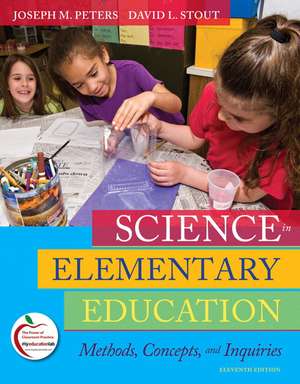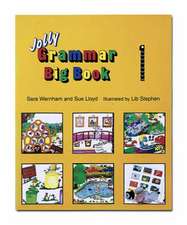Science in Elementary Education: Methods, Concepts, and Inquiries
Autor Joseph M. Peters, David L. Stouten Limba Engleză Paperback – 31 ian 2010
Preț: 1297.49 lei
Preț vechi: 1685.04 lei
-23% Nou
Puncte Express: 1946
Preț estimativ în valută:
248.30€ • 269.62$ • 208.58£
248.30€ • 269.62$ • 208.58£
Carte disponibilă
Livrare economică 01-15 aprilie
Preluare comenzi: 021 569.72.76
Specificații
ISBN-13: 9780135031506
ISBN-10: 0135031508
Pagini: 556
Dimensiuni: 216 x 274 x 20 mm
Greutate: 1.04 kg
Ediția:11Nouă
Editura: Pearson Education
Locul publicării:Boston, United States
ISBN-10: 0135031508
Pagini: 556
Dimensiuni: 216 x 274 x 20 mm
Greutate: 1.04 kg
Ediția:11Nouă
Editura: Pearson Education
Locul publicării:Boston, United States
Descriere
Substantially rewritten to focus on inquiry teaching and learning as espoused in the National Science Education Standards, the new edition of Science in Elementary Education: Methods, Concepts, and Inquiries will prepare pre-service teachers to plan, facilitate, adapt, and assess inquiry experiences consistent with today’s science classroom. It accomplishes this by implementing the 6E model of inquiry teaching, addressing the planning and needs of inquiry teaching classrooms, and describing the materials teachers need to get up and running.
This practical text includes over 350 Teaching Tips throughout and Twelve Inquiry Units that model constructivist applications, build conceptual knowledge, and provide a bank of classroom-tested lessons to use in science classrooms.
This practical text includes over 350 Teaching Tips throughout and Twelve Inquiry Units that model constructivist applications, build conceptual knowledge, and provide a bank of classroom-tested lessons to use in science classrooms.
Cuprins
Part One METHODS FOR TEACHING ELEMENTARY SCHOOL SCIENCE
Ch. 1: Inquiring Minds in the Classroom
A National Focus on Inquiry
The Nature of Science
How Do Children and Society Benefit When Science Is Taught Properly?
Ch. 2: Discovering Science Through Inquiry
Inquiry and Its Role in Promoting Scientific Literacy
Inquiry as a Paradigm for Teaching and Learning
Inquiry and Scientists
Inquiry and Children
Convergence of Ideas
Constructivism and Science Teaching and Learning
A Constructivist Approach to Teaching
Preparing for Inquiry in Your Classroom
Ch. 3: Planning for Inquiry
Planning Inquiry Experiences
Development of a 6E Lesson
National Standards and Planning
Ch. 4: Inquiry and Assessment
Assessment Today
NCLB
Linking Assessment to Inquiry
The 6E Model and Assessment
Authentic Assessment
Characteristics of Good Assessment
Performance-Based Assessment
Project-Based Assessment
Peer or Individual Assessments
Interviews
Journals
Portfolios
Concept Maps
Teacher Observations
Open-Ended Questions
Assessing Attitudes
Ch. 5: Inquiry and Science as Practice
Inquiry and Scientific Skill Development
The Goals of Science as Practice
Four Strands of Science
Scientific Skills in Support of Science as Practice
Observing
Classifying
Measuring
Communicating
Inferring
Predicting
Experimenting
Scientific Attitudes
Curiosity
Inventiveness
Critical Thinking
Persistence
Uncertainty
Developing Attitudes
Ch. 6: Inquiry Experiences for All Children
Celebrating Diversity
Cultural Diversity
Linguistic Diversity
Gender Equality
Teaching Students with Special Needs
Inclusive Classrooms
Assisting Students with Disabilities
Children with Disabilities
Working with Gifted Students
Ch. 7: Inquiry Learning Opportunities
Opportunity to Learn
Historical Perspective
Science Fairs
Invention Conventions
Science Learning Centers
Science Projects
Science Learning Resources
Technology Education as a Science Learning Opportunity
Ch. 8: Professional Development in Support of Inquiry
Lifelong Learning
Establishing Inservice Programs
A Personal View
Mentoring Programs
Teacher as Researcher
Part Two CONCEPTS AND INQUIRIES FOR TEACHING ELEMENTARY SCHOOL SCIENCE
Inquiry Unit 1: Physical Science
Light Energy and Color Benchmarks
Pathways of Light Concepts
Light Refraction Concepts
Color Concepts
Color Blindness
Perception and the Eye Concepts
Heat Energy Benchmarks
Expansion and Contraction Concepts
Changing States of Matter Concepts
Temperature and Heat Energy Concepts
The Calorie and the BTU
Conduction, Convection, and Radiation Concepts
Sound Energy Benchmarks
Sound Vibration Concepts
How Sounds Travel Concepts
Reflected and Absorbed Sounds Concept
How Pitch Changes Concepts
Hearing and Locating Sounds Concepts
Magnetic Interaction Benchmarks
Magnets and What They Attract Concepts
Making Magnets Concepts
Fields of Force Concepts
Magnetic Pole Concepts
Magnetic Therapy and Care of Magnets Concepts
Electrical Energy Benchmarks
Closed and Open Circuit Concepts
Series and Parallel Circuit Concepts
Electrical Flow Concepts
Electromagnet Concepts
Generating Electricity Concepts
Simple Machine Benchmarks
Screws and Inclined Planes Concepts
Lever Concepts
Wheel and Axle Concepts
Pulley Concepts
Motion and Friction Concepts
Simple Machine Print Resources
Inquiry Unit 2: Life Science
Plant Life Benchmarks
Seed-Related Concepts
Vegetative Reproduction Concepts
Environmental Conditions Concepts
Plant Part and Function Concepts
Adaptation and Survival Concepts
Molds and Fungi Concepts
Animal Life Benchmarks
Classification of Animals Concepts
Animals with Backbones Concepts
Animals Without Backbones Concepts
Ecological Concepts
Human Body and Nutrition Benchmarks
Skeletal and Muscle Systems Concepts
Nervous System Concepts
Circulatory and Respiratory Systems Concepts
Digestive System Concepts
Food and Nutrition Concepts
Human Body and Nutrition Print Resources
Inquiry Unit 3: Earth and Space Science
The Earth’s Changing Surface Benchmarks
Weathering and Erosion Concepts
Soil and its Makeup Concepts
Building Up of the Land Concepts
How Rocks Are Formed Concepts
Water, Air, and Weather Benchmarks
Water Concepts
Air and Its Properties Concepts
Weather Concepts
Condensation
The Earth in Space Benchmarks
Time and the Seasons Concepts
Moon, Earth, and Sun Orbits Concepts
Solar System and Beyond Concepts
Gravity and the Laws of Motion Concepts
The Earth in Space Print Resources
Appendix A: Professional Bibliography
Appendix B: Science Curriculum Projects
Appendix C: Commercial Science Suppliers
Appendix D: Environments and Nutrition for Classroom Animals
Appendix E: Summary of Children’s Thinking
Appendix F: State Education Agencies
References
Index
Ch. 1: Inquiring Minds in the Classroom
A National Focus on Inquiry
The Nature of Science
How Do Children and Society Benefit When Science Is Taught Properly?
Ch. 2: Discovering Science Through Inquiry
Inquiry and Its Role in Promoting Scientific Literacy
Inquiry as a Paradigm for Teaching and Learning
Inquiry and Scientists
Inquiry and Children
Convergence of Ideas
Constructivism and Science Teaching and Learning
A Constructivist Approach to Teaching
Preparing for Inquiry in Your Classroom
Ch. 3: Planning for Inquiry
Planning Inquiry Experiences
Development of a 6E Lesson
National Standards and Planning
Ch. 4: Inquiry and Assessment
Assessment Today
NCLB
Linking Assessment to Inquiry
The 6E Model and Assessment
Authentic Assessment
Characteristics of Good Assessment
Performance-Based Assessment
Project-Based Assessment
Peer or Individual Assessments
Interviews
Journals
Portfolios
Concept Maps
Teacher Observations
Open-Ended Questions
Assessing Attitudes
Ch. 5: Inquiry and Science as Practice
Inquiry and Scientific Skill Development
The Goals of Science as Practice
Four Strands of Science
Scientific Skills in Support of Science as Practice
Observing
Classifying
Measuring
Communicating
Inferring
Predicting
Experimenting
Scientific Attitudes
Curiosity
Inventiveness
Critical Thinking
Persistence
Uncertainty
Developing Attitudes
Ch. 6: Inquiry Experiences for All Children
Celebrating Diversity
Cultural Diversity
Linguistic Diversity
Gender Equality
Teaching Students with Special Needs
Inclusive Classrooms
Assisting Students with Disabilities
Children with Disabilities
Working with Gifted Students
Ch. 7: Inquiry Learning Opportunities
Opportunity to Learn
Historical Perspective
Science Fairs
Invention Conventions
Science Learning Centers
Science Projects
Science Learning Resources
Technology Education as a Science Learning Opportunity
Ch. 8: Professional Development in Support of Inquiry
Lifelong Learning
Establishing Inservice Programs
A Personal View
Mentoring Programs
Teacher as Researcher
Part Two CONCEPTS AND INQUIRIES FOR TEACHING ELEMENTARY SCHOOL SCIENCE
Inquiry Unit 1: Physical Science
Light Energy and Color Benchmarks
Pathways of Light Concepts
Light Refraction Concepts
Color Concepts
Color Blindness
Perception and the Eye Concepts
Heat Energy Benchmarks
Expansion and Contraction Concepts
Changing States of Matter Concepts
Temperature and Heat Energy Concepts
The Calorie and the BTU
Conduction, Convection, and Radiation Concepts
Sound Energy Benchmarks
Sound Vibration Concepts
How Sounds Travel Concepts
Reflected and Absorbed Sounds Concept
How Pitch Changes Concepts
Hearing and Locating Sounds Concepts
Magnetic Interaction Benchmarks
Magnets and What They Attract Concepts
Making Magnets Concepts
Fields of Force Concepts
Magnetic Pole Concepts
Magnetic Therapy and Care of Magnets Concepts
Electrical Energy Benchmarks
Closed and Open Circuit Concepts
Series and Parallel Circuit Concepts
Electrical Flow Concepts
Electromagnet Concepts
Generating Electricity Concepts
Simple Machine Benchmarks
Screws and Inclined Planes Concepts
Lever Concepts
Wheel and Axle Concepts
Pulley Concepts
Motion and Friction Concepts
Simple Machine Print Resources
Inquiry Unit 2: Life Science
Plant Life Benchmarks
Seed-Related Concepts
Vegetative Reproduction Concepts
Environmental Conditions Concepts
Plant Part and Function Concepts
Adaptation and Survival Concepts
Molds and Fungi Concepts
Animal Life Benchmarks
Classification of Animals Concepts
Animals with Backbones Concepts
Animals Without Backbones Concepts
Ecological Concepts
Human Body and Nutrition Benchmarks
Skeletal and Muscle Systems Concepts
Nervous System Concepts
Circulatory and Respiratory Systems Concepts
Digestive System Concepts
Food and Nutrition Concepts
Human Body and Nutrition Print Resources
Inquiry Unit 3: Earth and Space Science
The Earth’s Changing Surface Benchmarks
Weathering and Erosion Concepts
Soil and its Makeup Concepts
Building Up of the Land Concepts
How Rocks Are Formed Concepts
Water, Air, and Weather Benchmarks
Water Concepts
Air and Its Properties Concepts
Weather Concepts
Condensation
The Earth in Space Benchmarks
Time and the Seasons Concepts
Moon, Earth, and Sun Orbits Concepts
Solar System and Beyond Concepts
Gravity and the Laws of Motion Concepts
The Earth in Space Print Resources
Appendix A: Professional Bibliography
Appendix B: Science Curriculum Projects
Appendix C: Commercial Science Suppliers
Appendix D: Environments and Nutrition for Classroom Animals
Appendix E: Summary of Children’s Thinking
Appendix F: State Education Agencies
References
Index
Notă biografică
Joe Peters taught K-12 science before joining the UWF faculty. He has numerous presentations and publications, remains active in K-12 classrooms, and is Editor Emeritus of the Journal of Elementary Science Education. Other service includes a Distinguished Service Award (NARST), Leadership Award (NSELA), Executive Secretary for ASTE, and representation to ICASE, Triangle Coalition, and CSSP.
Caracteristici
- Includesover 350 Teaching Tips throughout–starting points, activities, or elaborations on a science teaching concept.
- Twelve Inquiry Units model constructivist applications, build conceptual knowledge, and provide a bank of classroom-tested lessons to use in science classrooms, so students can see concrete examples of the inquiry approach.
- Benchmarks and Standards feature found throughout the chapters help students see how to integrate the National Science Education Standards in their own teaching.
- Technology Chapter includes not only discussions on design technology and the applications of technology to advance science but also the latest educational technology to promote learning in science classrooms.
- Provides coverage ofcurrent technology issues
Caracteristici noi
- NEW! Integrates the effective and extensively-researched 6E Instructional Model, which expands on the popular 5E model (Engagement, Exploration, Explanation, Elaboration, Evaluation) to include E-Learning, as a theme throughout.
- NEW! Integrates MyEducationLab explorations throughout, optimizing blended and online learning, with additional suggestions for enhancing online experiences as found in the instructor's manual.
- NEW! Includes Technological Pedagogical Content Knowledge (as ascribed by the AACTE), with E-Learning links throughout the text, use of the MyEducationLab website for video support activities, and over 200 web discussion questions which can be completed through an enterprise e-learning system (i.e., Blackboard, Desire2Learn), a free social networking site (i.e., Ning), or a free wiki development site (i.e., Wetpaint), reinforcing key concepts found in the text and helping to build students’ technical proficiency.
- NEW! Extensive use of discussion items reinforces concepts presented in the methods chapters and promotes further dialogue.
- NEW! The Backwards Design Model (Identify Desired Results, Determine Acceptable Evidence, and Plan Learning Experiences and Instruction) is used as a model for planning and assessment effectiveness (Chs. 3 and 4).
- NEW! Chapter 8 includes professional development, lifelong learning, action research, and mentoring, exposing candidates to the need to continue learning beyond initial certification.
Textul de pe ultima copertă
Substantially rewritten to focus on inquiry teaching and learning as espoused in the National Science Education Standards, the new edition of "Science in Elementary Education: Methods, Concepts, and Inquiries" will prepare pre-service teachers to plan, facilitate, adapt, and assess inquiry experiences consistent with today s science classroom. It accomplishes this by implementing the 6E model of inquiry teaching, addressing the planning and needs of inquiry teaching classrooms, and describing the materials teachers need to get up and running. This practical text includes over 350 Teaching Tips throughout and Twelve Inquiry Units that model constructivist applications, build conceptual knowledge, and provide a bank of classroom-tested lessons to use in science classrooms."








